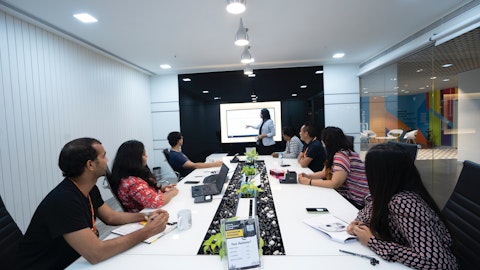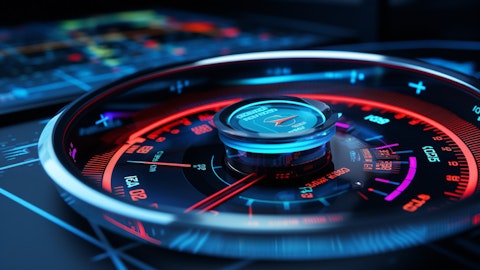Cadence Design Systems, Inc. (NASDAQ:CDNS) Q4 2023 Earnings Call Transcript February 12, 2024
Cadence Design Systems, Inc. beats earnings expectations. Reported EPS is $1.38, expectations were $1.34. Cadence Design Systems, Inc. isn’t one of the 30 most popular stocks among hedge funds at the end of the third quarter (see the details here).
Operator: Good afternoon. My name is Brianna and I will be your conference operator today. At this time, I would like to welcome everyone to the Cadence Fourth Quarter and Fiscal Year 2023 Earnings Conference Call. All lines have been placed on mute to prevent any background noise. After the speakers’ remarks, there will be a question-and-answer session. [Operator Instructions] Thank you. I will now turn the call over to Richard Gu, Vice President of Investor Relations for Cadence. Please go ahead, sir.
Richard Gu: Thank you, operator. I’d like to welcome everyone to our fourth quarter of 2023 earnings conference call. I’m joined today by Anirudh Devgan, President and Chief Executive Officer, and John Wall, Senior Vice President and Chief Financial Officer. The webcast of this call and a copy of today’s prepared remarks will be available on our website, cadence.com. Today’s discussion will contain forward-looking statements, including our outlook on future business and operating results. Due to risks and uncertainties, actual results may differ materially from those projected or implied in today’s discussion. For information on factors that could cause actual results to differ, please refer to our SEC filings, including our most recent Forms 10-K and 10-Q, CFO commentary, and today’s earnings release.
All forward-looking statements during this call are based on estimates and information available to us as of today, and we disclaim any obligation to update them. In addition, we will present certain non-GAAP measures which should not be considered in isolation from or as a substitute for GAAP results. Reconciliation of GAAP to non-GAAP measures are included in today’s earnings release. For the Q&A session today, we would ask that you observe a limit of one question and one follow-up. Now, I’ll turn the call over to Anurudh.
Anirudh Devgan: Thank you, Richard. Good afternoon, everyone, and thank you for joining us today. I’m pleased to report that Cadence delivered an outstanding Q4, wrapping up a record 2023, achieving 15% revenue growth, 42% non-GAAP operating margin, and over 20% non-GAAP EPS growth for the year. We exited 2023 with a record backlog of $6 billion, as customers increasingly committed to our chip-to-system integrated design and analysis platforms. We expect our innovative solutions to continue driving broad-based business momentum in 2024. John will provide more details in a moment. Secular trends of digital transformation, hyperscale computing and autonomous driving, all bolstered by an AI super-cycle, continue to fuel strong broad-based design activity.
We continue successfully executing to our Intelligent System Design strategy, that triples our TAM opportunity while greatly expanding our portfolio. Our innovative engine delivered several significant products including most recently, the revolutionary Millennium M1 platform, the industry’s first accelerated multi-physics supercomputing platform. The platform tightly integrates our Fidelity CFD software with high-performance GPUs and combines AI, HPC and digital twin technology to deliver an unprecedented 20x energy efficiency and up to 100x design impact. We were honored to have customers including Honda, Boeing and GE as speakers at our launch event. We substantially grew our footprint at market shaping customers and furthered our relationships with key ecosystem partners.
We furthered our partnership with Intel Foundry through a strategic multi-year agreement on providing design software and leading IP at multiple Intel advanced nodes, thereby advancing Intel’s IDM 2.0 strategy and accelerating mutual customer success. Cadence is at the forefront of the AI revolution, closely partnering with marquee companies on their trailblazing AI designs for training and inference from cloud to the edge. NVIDIA and Cadence have collaborated closely over several years, and in Q4, we deepened our partnership through a meaningful expansion of our hardware solutions and EDA software. Earlier in the quarter we announced our work on Cadence.ai with NVIDIA’s Nemo Retriever, and now we’re thrilled to deepen our partnership and extend it to the new Millennium MultiPhysics Supercomputer and SaaS solution which is co-optimized with NVIDIA’s Accelerated Computing and AI platform.
And as the exclusive EDA partner of Arm Total Design, Cadence and Arm are closely collaborating to accelerate the development of custom SoCs based on the Neoverse Compute Subsystem. Over the year, we’ve continued building out our generative Cadence.ai portfolio, the industry’s broadest AI offerings spanning chip to board to system, and delivering exceptional optimization and productivity benefits. Earlier in Q2, we introduced Virtuoso Studio and Allegro X AI, bringing AI to custom/analog and PCB designs. And in Q4, we added Voltus InsightAI for automatically addressing voltage drop violations. We also pioneered bringing LLM capabilities to chip design, successfully helping Renesas accelerate functional specification to final design. Accelerating momentum of our Cadence.ai portfolio has led to an almost tenfold increase in the number of customers adopting our GenAI solutions in 2023, as customers embrace the technology to develop optimized products much more efficiently.
Now, let’s talk about some of the product highlights for Q4 and 2023. Rising system complexity and challenges stemming from the growing hyperconvergence of the electrical, mechanical and physical worlds, are driving the need for a seamless platform solution across design, packaging, simulation, and analysis. We made this a core tenet of our Intelligent System Design growth strategy six years ago, and our System Design and Analysis business continued its strong momentum, delivering 18% year-over-year growth in Q4 and 22% growth for the year. PCB and advanced packaging are linchpin technologies that sit at the crucial intersection of mechanical and electrical domains and Cadence’s rich heritage in these areas remain a key strategic differentiator, especially in the emerging chiplet era.
We continue advancing these technologies with Allegro X AI providing greater than 10x acceleration in PCB design, and endorsed by Schenider Electric and Kioxia at its launch. Our multi-physics analysis portfolio couples our expertise in physics-based modeling with AI-driven optimization and is delivering superior results to customers across multiple vertical segments, especially aerospace and defense, and automotive. Recently, we launched Celsius Studio, the industry’s first complete AI thermal design and analysis solution for electronic systems, delivering up to a 10x performance benefit over legacy systems, with endorsements by Samsung and BAE Systems. And Wistron, a leading technical services provider used Optimality’s AI-driven optimization technology and Clarity for fast, accurate electromigration in-design analysis, improving design reliability while realizing a 2x improvement in turnaround time.

Our digital IC business finished another strong year with 22% revenue growth in Q4, as our solutions continued gaining share at market shaping customers, especially at the most advanced nodes. Our digital software is proliferating in all top 20 semiconductor companies and our digital full flow was adopted by 34 additional customers during the year. We are very pleased with the accelerating momentum of our flagship Cadence Cerebrus GenAI solution, whose transformative PPA and productivity benefits have led to its deployment in all our top 10 digital customers and used in well over 300 tapeouts. In Q4, Cadence Cerebrus run rate more than quadrupled at several market shaping customers and it also drove significant digital full flow expansions at two top tier semi customers Our Integrity 3D-IC platform is the industry’s only unified 3D-IC design and analysis platform and ties our best-in-class SoC and package design technologies with system-level planning and analysis.
In Q4, GUC successfully used Integrity to tapeout a complex 3D stacked die design with a wafer-on-wafer structure on an advanced FinFET node. Next, I will talk about our Functional Verification business, which had another remarkable year, delivering 11% year-over-year revenue growth in Q4 and 22% growth for the full year. Escalating system and software bring-up challenges, along with the pressing need for first-pass silicon success, continued driving strong demand for our Functional Verification solutions. Our best-in-class dynamic duo of Palladium Z2 and Protium X2 platforms delivered another record year, with strong momentum across AI, hyperscale, auto and mobile. Virtually all of the top hyperscalers are Palladium customers and the majority of them are also Dynamic Duo customers.
Last month, we announced a new set of Palladium Z2 applications that included the industry’s first four state emulation and mixed signal modeling capabilities, that will significantly accelerate SoC verification. Marquee customers including NVIDIA and Samsung supported the announcement. Our hardware family added 26 new and over 110 repeat customers during the year, with the top three deals being with a global marquee systems company, the leading AI systems company, and a leading communications services company. Demand for the Duo greatly exceeded our expectations with more than two-thirds of the orders in the year including both platforms. Our Custom IC Virtuoso and Spectre franchise solutions tackle the most complex challenges in analog, mixed signal, RF design and circuit simulation, and are increasingly crucial for our customers.
Building on our market leadership, our Custom IC revenue grew 16% year-over-year in Q4. Customer interest in our recently announced Virtuoso Studio is strong with over 2,000 downloads so far and adoption of our newer Spectre platform products continues to ramp. Virtuoso had a major win with a top global memory company, which replaced its internal tools with our technology. Our IP business drove a strong finish to the year growing 36% year-over-year in Q4. We continued to sharpen our star IP strategy with targeted acquisitions such as Rambus PHY IP and Invecas to capture market opportunities offered by AI and heterogenous integration. Customer interest in the Rambus PHY assets, especially HBM and GDDR IP have been extremely positive which have already been instrumental in closing some strategic deals.
Our Invecas acquisition is also highly synergistic to the strategy, adding a skilled engineering team with expertise in delivering custom solutions across design, product engineering, advanced packaging, and embedded software. In closing, we are pleased with our outstanding performance in 2023 and are excited by the business momentum and market opportunities in 2024. Now, I will turn it over to John to provide more details on the Q4 results and our 2024 outlook.
John Wall: Thanks, Anirudh, and good afternoon, everyone. I am pleased to report that Cadence delivered a strong Q4 and 2023, driven by growth across all of our businesses. Robust design activity and customer demand, coupled with our strong execution, helped us to achieve revenue growth of 15% and EPS growth of over 20% for the year. Fourth quarter bookings were strong, and I am pleased that we achieved record backlog and record current remaining performance obligation levels, finishing the year with approximately $6.0 billion in backlog and approximately $3.2 billion in cRPO. Here are some of the financial highlights from the fourth quarter and the year, starting with the P&L. Total revenue was $1.069 billion for the quarter and $4.090 billion for the year.
GAAP operating margin was 31.5% for the quarter and 30.6% for the year. Non-GAAP operating margin was 42.9% for the quarter and 42.0% for the year. GAAP EPS was $1.19 for the quarter and $3.82 for the year. Non-GAAP EPS was $1.38 for the quarter and $5.15 for the year. Next, turning to the balance sheet and cash flow, our cash balance was $1.008 billion at year-end, while the principal value of debt outstanding was $650 million. Operating cash flow in the fourth quarter was $272 million and $1.35 billion for the full year. DSOs were 43 days. And we used $700 million to repurchase Cadence shares during the year. Before I provide our outlook for Q1 and 2024, I’d like to share some assumptions that are embedded in our outlook. In 2023, our up-front revenue mix increased to approximately 16% largely due to strong hardware demand.
In 2024, we expect another record hardware revenue year and strong IP growth. And as a result, at the midpoint, our outlook assumes that our up-front revenue mix for the year will increase to approximately 17.5%. In Q1 2023, our up-front revenue mix was approximately 20%, largely due to our effort to improve hardware delivery lead times at the start of last year. In Q1 2024, at the midpoint, our outlook assumes an up-front revenue mix of approximately 14%. Our non-GAAP EPS outlook is based on a tax rate of 16.5%. And finally, our outlook for Q1 and 2024 is based on our usual assumption that export control regulations in place today, remain substantially similar for the remainder of the year. In our outlook for 2024, we expect: revenue in the range of $4.55 billion to $4.61 billion; GAAP operating margin in the range of 32% to 33%; non-GAAP operating margin in the range of 42% to 43%; GAAP EPS in the range of $4.08 to $4.18; non-GAAP EPS in the range of $5.87 to $5.97; operating cash flow in the range of $1.35 billion to $1.45 billion; and we expect to use approximately 50% of our free cash flow to repurchase Cadence shares in 2024.
For Q1, we expect: revenue in the range of $990 million to $1.01 billion; GAAP operating margin in the range of 24.5% to 25.5%; non-GAAP operating margin in the range of 36.5% to 37.5%; GAAP EPS in the range of $0.74 to $0.78; and non-GAAP EPS in the range of $1.10 to $1.14. And as usual, we’ve published a CFO Commentary document on our Investor Relations website, which includes our outlook for additional items, as well as further analysis and GAAP to non-GAAP reconciliations. In conclusion, I am pleased that for 2023 we achieved revenue growth of 15% and EPS growth of over 20%; we achieved a seventh consecutive year of over 50% incremental non-GAAP operating margins, resulting in non-GAAP operating margin of 42%; and we finished the year with record backlog and cRPO, setting ourselves up for a great 2024.
As always, I’d like to thank our customers, partners, and our employees for their continued support. And with that, operator, we will now take questions.
See also Best Birth Injury Lawyers in Each of 30 Biggest Cities in the US and 30 Most Densely Populated Cities in the US.
Q&A Session
Follow Cadence Design Systems Inc (NASDAQ:CDNS)
Follow Cadence Design Systems Inc (NASDAQ:CDNS)
Receive real-time insider trading and news alerts
Operator: [Operator Instructions] Your first question comes from Jason Celino with KeyBanc Capital Markets. Please go ahead.
Jason Celino: Hey, guys. Happy Monday. So, maybe my first question on the backlog strengths, really impressive, especially given the hard year-over-year comp. John or Anirudh, what drove the strength here? It sounds like it’s hardware related, or maybe it’s broad-based. Anything helpful?
John Wall: Jason, yes, it was very broad-based, broad-based across geographies and broad-based across all of the businesses. Actually on the hardware front, you might recall this time last year, we finished with over six months of backlog for hardware. We addressed those lead times at the start of the year and now we’re down to a more normal eight weeks of hardware backlog. So, when you compare the backlog at the end of ’23 against the end of ’22, I think it reflects strong bookings, broad-based bookings across all geographies, across all businesses, but on the hardware side, slightly less hardware or maybe less hardware certainly in backlog at the end of ’23 versus the end of ’22.
Jason Celino: Okay. And then, when we think about 2024 as a whole, is it a big renewal year, or I guess how does 2024 look compared to other years, particularly ’23 when you think about renewal timing and things like that? Thanks.
John Wall: Yeah, great question, Jason. Last year was kind of very heavily weighted towards the second half of renewals. We don’t expect it to be that heavily weighted in the second half this year. Looking at software renewals and when they come due, if you look at the annual value, it’s probably weighted 40% first half to 60% second half.
Jason Celino: Thank you.
Operator: Your next question comes from Charles Shi with Needham. Please go ahead.
Charles Shi: Hi, good afternoon. I guess top of the mind of many investors, can you guys provide any thoughts on the Synopsys and Ansys merger or whatever you call it? Especially now, Cadence probably needs to execute that Intelligent System Design strategy more in an [organic way than inorganic] (ph) way. Any thoughts would be great. Thanks.
Anirudh Devgan: Yeah. Hi, Charles. This is Anirudh. So, as you know, we have been executing on our Intelligent System Design strategy for six years now. We started this in 2018 and we know for a while that there will be this convergence of electrical and mechanical domains. This convergence of system and semi companies, semi companies becoming system companies and system companies doing silicon, as you all know. And now we have commented that about 45% of our business is coming from system companies. But this is not — I mean, we have been executed on this from 2018 and focusing on, of course, our core business, which is EDA, expanding into SD&A, which is what we call System Design and Analysis, and of course AI over the last five, six years.
And if you look at our results on SD&A, even in 2023, our business revenue is up 22% in SD&A. And it has been up more than 20% for last several years, whereas that market is not really growing at that rate. So, we are gaining a lot of share in SD&A. And this is primarily due to our products, right, and our customer response. So, the customers have really embraced our strategy and embraced our product differentiation. So, we first started with Finite Element with Clarity, and that is benchmarking very well, winning a lot of share, a lot of customers. And then, recently, you must have seen our new product in CFD. CFD is a big market. That’s the — there are two big simulation areas in SD&A: one is finite element, which we are already ahead, and the other is CFD.
And with Millennium, this is like the one of the most revolutionary products in CFD in the last 30 years. And I can tell you more about Millennium later. And then, the third thing in our SDA strategy is we are the only company that has a very strong position in packaging and PCB, which is critical for chiplets and 3D-IC. So overall, I feel very confident in terms of our market position. The strategy we have implemented for six years, and I see a lot of growth and momentum going forward.
Charles Shi: Thanks, Anirudh. Maybe a follow-up. I do want to dig a little bit into your digital IC design and the signoff revenue. You reported last quarter, I think it’s exceeding $300 million. It has been bumping along $250 million since I think early part of 2022, but then it does seem to show some really good strength since second half ’23. You talked about the sheer gains, and I do understand this is the part where you have the most overlap with your direct competitors Synopsys. And just really curious, how sustainable is the strength you saw in Q4? And is there any color you can provide us on what’s driving the revenue upside for that business in fourth quarter? How should people think about the sustainability of that? Thanks.
Anirudh Devgan: Yeah, hi, Charles. That’s a good question on digital. I mean, there are multiple reasons driving that, but I would say the main reason — and we had good growth in Q4, as you saw in our digital business. But of course, the main reason that’s driving that is the AI super-cycle. So, there’s a lot more design activity. You will notice some of our key partners increasing the cadence of their major kind of product development. So, there’s AI. In AI, we participate in several ways. One is just the buildout of the AI infrastructure, which is, of course, our great partnership with NVIDIA and all the other hyperscalers. And then, also, our AI-enabled products like Cerebrus and Optimality and overall AI portfolio. So, as I mentioned in my prepared remarks, Cerebrus, which is the flagship product for digital implementation using AI, our business went up 4x, right?
So that’s also providing a lot of growth in terms of — so there’s one, there’s overall much more design activity, especially at the most advanced node, and then AI products provide acceleration on top of that. And then, the other thing that I had mentioned before, but as people use Cerebrus, which is the overall AI product in digital implementation, it also has a pull-through of the full flow, not just place and route, but also synthesis and signoff. So, what I’m very pleased to see is one AI products like Cerebrus are doing well, but they’re also pulling through synthesis. Our position has improved dramatically in synthesis in the last one year and also a lot of signoff engagement. So overall, I’m pretty pleased with the technology progress, the AI progress.
And also engagement with some big customers that traditionally were not using Cadence, and now, like we mentioned, all top 20 customers are using Cadence solutions in digital. So, we’ll see how it progresses, but I think it’s good progress on digital and I expect that to continue.
John Wall: And Charles, I would just add to that, in Q4, we saw some very good cash collections from customers that were kind of lower credit-worthy customers that we didn’t think we would collect those — that cash. So, it wasn’t in our forecast. So, we had some upside from that.
Charles Shi: Thanks.
Operator: Your next question comes from Vivek Arya with Bank of America Securities. Please go ahead.
Vivek Arya: Thanks for taking my question. I actually had a question on growth. Just kind of first on the segment side, IP growth has been more modest than the entire company growth. So, I was hoping if you could give us some color on that. But then, Anirudh, my bigger question is that, when I look at the overall sales growth for Cadence, right, so 19% in ’22, then 15% last year, and now 12% is what you’re guiding to for this year. I mean, these are impressive growth rates versus the semiconductor industry. But still it shows a deceleration, right, for the last few years, which is very different than the acceleration that we see for a lot of other semiconductor companies that are exposed to the AI and generative AI theme. So, what is the right way to interpret this deceleration in your sales?
Like, should we be expecting acceleration back at some point as some of these AI initiatives get bigger? Or what is the right way to interpret and compare your growth rate versus the acceleration of growth in a number of the AI names?
Anirudh Devgan: Yeah, Vivek, good question. So, first on the IP part, like in ’23, I think first three quarters we had, the growth was much more challenged. It’s primarily with the compare the previous year, but — some of the macro uncertainties. But as you can see in Q4, we had very strong growth in IP, more than 30% growth in IP. And also, this whole AI super-cycle, as you know, is driving much more disaggregation, right? So, the 3D-IC is concentrated at HPC and AI application. And that requires more IP, like UCIe or SerDes IP, and then HPM and memory IP. And that’s why we acquired assets of — the five assets of Rambus. And overall our own portfolio in UCIe and DDR and all is doing pretty well. And then, we did several acquisitions to improve our talent in IP.
So, overall I do think, because of AI, because of our own actions, that IP should do much better in 2024. That’s our current modeling. And ’23 had some unusual challenges, like I mentioned. But going forward, IP business should improve. And we have focused on profitability over the last few years in our IP business. And I think I’m pleased to say that the profitability levels we are happy with now, okay? So, now, I think we can focus more on growth and expanding our portfolio. And you may have also seen that there’s all these other activity at most advanced nodes and more foundries. And we’re also pleased with our partnership with Intel, Intel Foundry that we just announced today. And also all the other major foundries, but we are very glad to do much more with the IFS and that should also help our IP business going forward.
John Wall: And Vivek, I’d just like to add, I mean, you asked about how to look at the revenue growth. We tend to look over a three-year CAGR, because most of our customers are in three-year baseline contracts on the software side. And if you look at — since 2017, our three-year CAGR has been accelerating and it continues to accelerate. In 2022, we hit 15%. We actually exceeded 15% on a three-year CAGR basis. For last year, we’re very, very pleased that we were over 15% again. And then, at the midpoint of the guide for ’24, the three-year CAGR is about 15.3%. So that would be three consecutive years of over 15% revenue growth on a three-year CAGR basis. Now, from time to time, you can get some lumpiness in things like hardware timing or IP timing, and that can distort individual quarters or individual years. But we do think looking over a three-year CAGR basis is probably the best way to look at it. That’s how we look at it ourselves.
Vivek Arya: Got it. And for my follow-up, maybe John, one or two clarifications. What’s the assumption for China contribution in ’24? And then, the incremental EBIT, I think from the guidance, it seems like it’s below 50%, right? It’s still impressive, but it is below what we have been used to the last few years. If you could clarify that, that’ll be very helpful also. Thank you.





